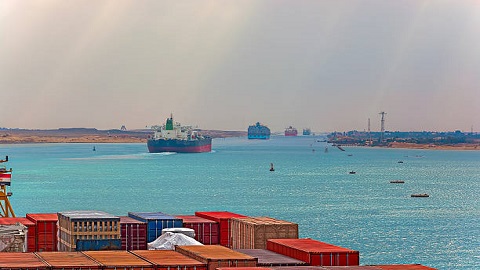
Suez Crisis
The Suez Crisis occurred in an area where tension and conflict were already high, and it’s become a focal point that reaches far beyond its origin. What’s been happening is that Iran-backed Houthi militants in the Red Sea have been targeting ships passing through the Bab al-Mandab strait.
This has caused a major disruption in global trade, leading big shipping companies to halt their services. The attacks are getting more serious with advanced weapons involved, putting the stability of this important trade route at serious risk.
Table of Contents
Suez Crisis:
It’s not just about the economy; there are worries about potential military escalation in the Middle East and Suez Crisis. This whole situation is pushing major global players like the United States and its allies into a tough spot where they have to balance protecting worldwide trade while dealing with the complexities of potential conflicts in the region.
1. Naval Crisis Impacting Global Shipping:
The Suez Crisis escalated further due to the conflict involving Iran-backed Houthi militants. Their actions disrupted vital trade routes, prompting major container-shipping companies like CMA CGM, Hapag-Lloyd, Maersk, and MSC to suspend Red Sea services. This move not only jeopardized Suez Canal traffic but also compelled the U.S. and its allies to bolster naval presence in order to secure the shipping lanes.
The Houthis, armed with sophisticated weaponry, intensified the crisis by targeting global shipping, resulting in increased attacks on vessels and a looming threat to vital trade chokepoints like Bab al-Mandab.
This disruption significantly impacted 12% of global trade volume, posing economic risks such as heightened shipping costs, supply-chain disruptions, and potential oil supply threats. As tensions rise, diplomatic solutions are urgently needed amidst the possibility of military escalations to safeguard international trade and stability in the midst of the Suez Crisis.
2. Significance of Bab al-Mandab Strait:
The Bab al-Mandab Strait, a crucial pathway for global trade, faces heightened danger due to ongoing Houthi assaults. These attacks have led to the closure of the strait, disrupting 12% of trade volume and impacting almost a third of global container traffic.
The Houthi assaults, which aim to support Gaza, have intensified, utilizing advanced weaponry like anti-ship ballistic missiles. This has prompted major shipping companies such as Maersk and cma cgm to cease their services, redirecting ships away from the Red Sea. This crisis poses a significant threat to worldwide commerce, causing increased trade costs, insurance premiums, and the potential for disruptions in supply chains.
Amidst this situation, reminiscent of the Suez Crisis, there’s a looming concern about the potential for military intervention by Western nations to restore passage. However, the complexities surrounding Houthi motives and Iranian involvement add layers of complication to finding viable solutions.
3. Specific Attacks and Escalation:
The Houthis, labeled a terrorist organization by certain countries, have increased their attacks on international shipping, using drones and ballistic missiles to target vessels. The recent mv Palatium III incident saw the first deployment of an anti-ship ballistic missile, significantly raising the dangers for ships navigating the Red Sea. This has led major shipping companies to halt their services, effectively halting a crucial trade route.
Consequently, naval activity has surged, and there’s talk of potential military involvement in the Middle East to restore passage and address the economic repercussions. This crisis, compounded by Iran-backed militants, presents significant risks to global trade and heightens concerns about a broader conflict. It draws parallels with the historic Suez Crisis, amplifying the urgency to resolve the situation and prevent further disruptions to international commerce.
4. Shipping Industry Response:
The Suez Crisis erupted when Houthi militants, supported by Iran, launched attacks on vessels in the Red Sea. As a result, major shipping companies like CMA CGM, Hapag-Lloyd, Maersk, and MSC had to halt services through the Suez Canal. This move poses a serious threat to global trade, affecting 53% of container trade.
The crisis is not only escalating tensions in the already volatile Middle East but also prompting Western nations to step up efforts to protect shipping routes and weigh potential military responses. Consequently, the world economy faces the impact of increased shipping costs, potential disruptions in the supply chain, and higher insurance premiums. The actions of the Houthis, targeting multiple countries, have raised grave concerns about Iran’s influence and the possibility of a wider conflict.
5. Economic and Global Ramifications:
The escalating attacks by Iran-backed Houthi militants in the Red Sea, known as the Suez Crisis, pose a significant threat to global trade through the Suez Canal. Shipping giants like Maersk, Hapag-Lloyd, and others halting services exacerbate potential disruptions, compounding the challenges faced. These threats, ranging from vessel targeting to ballistic missile strikes, compel ships to reroute around Africa.
Consequently, this amplifies trade costs, extends shipping durations, and inflates insurance expenses. Moreover, this crisis not only imperils Egypt’s Suez revenue but also endangers approximately a third of the world’s oil supply, which usually transits through the Arabian Sea. To counter these risks, Western nations have heightened naval presence in the region, aiming to restore safe passage. However, addressing
6. Houthi Motives and Iran’s Role:
Despite proclaiming support for Palestinians in Gaza, the Houthi group, labeled a terrorist organization by several nations such as the United States, Saudi Arabia, and the United Arab Emirates, has intensified its assaults on global shipping, notably in the Red Sea. This rise in attacks seems disconnected from their stated goal, given that most targeted ships have no ties to Israel.
It hints at a wider scheme orchestrated by Iran to exert regional pressure on Israel through the actions of the Houthis. This situation could potentially intertwine with historical events like the Suez Crisis, leading to significant worldwide economic and geopolitical implications.
7. Potential Responses and Diplomatic Solutions:
Efforts through diplomacy could potentially bring some relief to the crisis, with discussions possibly taking place between Saudi Arabia, the UAE, and the Houthis. Despite this, there’s a growing possibility of a military intervention. Amidst this, the ongoing struggles of a multinational task force to prevent Houthi attacks persist.
The available options vary, from considering armed escorts for merchant ships to contemplating direct strikes on Houthi facilities. However, there’s an inherent risk of broader conflict escalation. This situation mirrors the complexities seen during historical events like the Suez Crisis.
Conclusion:
The crisis in the Red Sea, orchestrated by Houthi militants, underscores multifaceted challenges that extend well beyond the realm of maritime security. The disruption caused by attacks on global shipping, escalating tensions, and the intricate web of regional alliances poses a formidable dilemma for international stakeholders.
The economic repercussions of a prolonged closure of this critical trade artery through the Suez Canal reverberate across global supply chains and portend heightened shipping costs and supply-chain disruptions.
As nations grapple with the complexities of responding to Houthi provocations, diplomatic avenues to de-escalate the crisis emerge, albeit against a backdrop of potential military interventions. Balancing economic imperatives with geopolitical intricacies remains paramount to mitigate the unfolding crisis without exacerbating the already volatile Middle Eastern dynamics.





